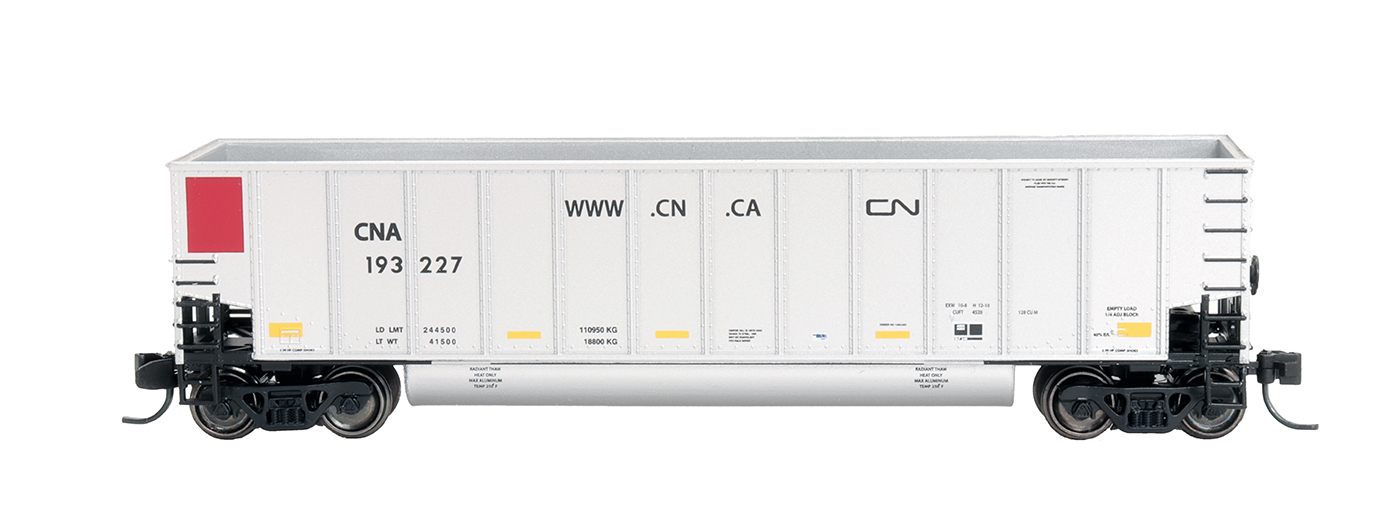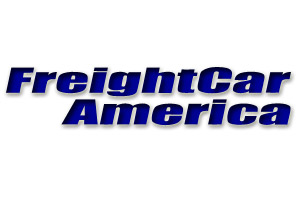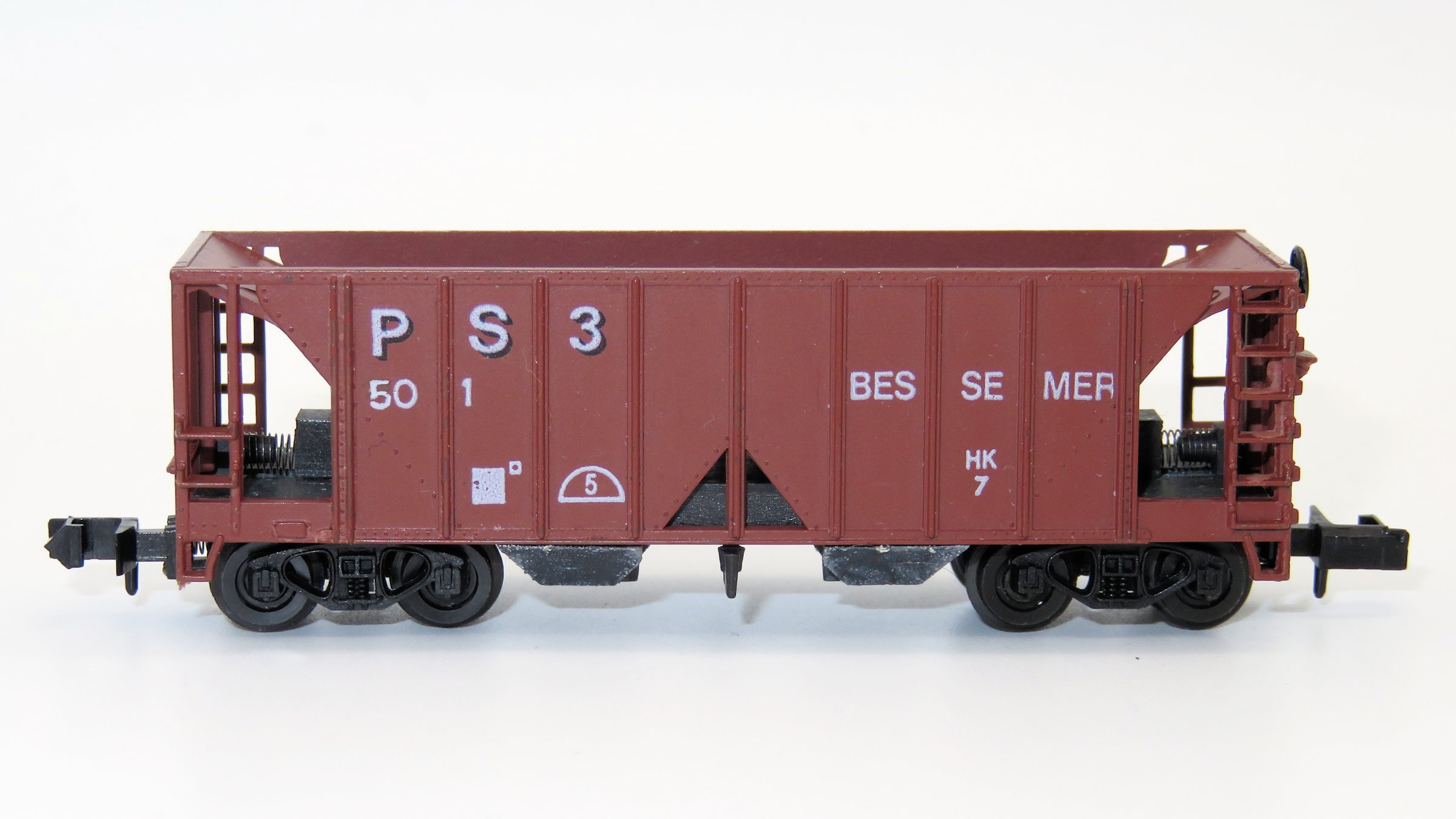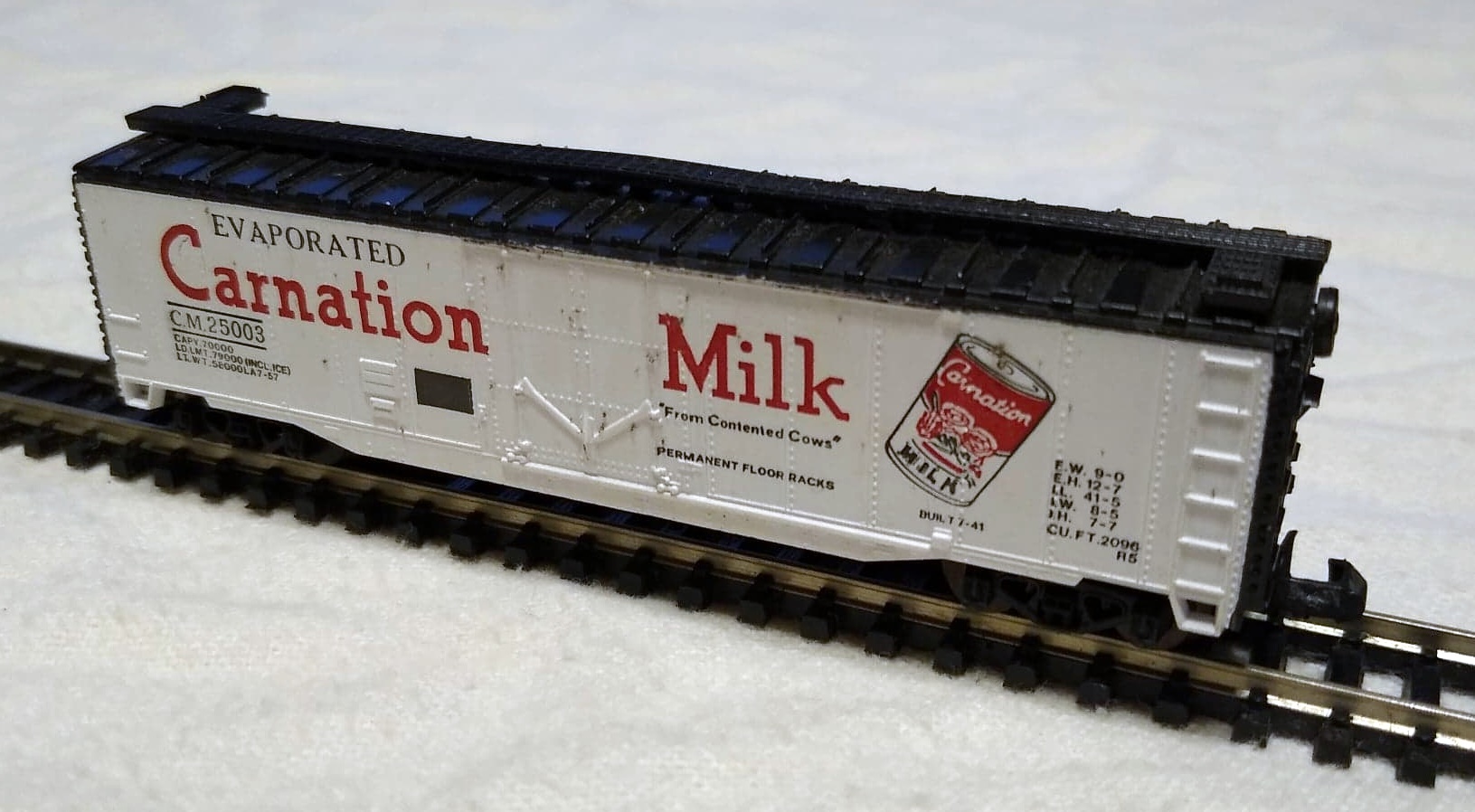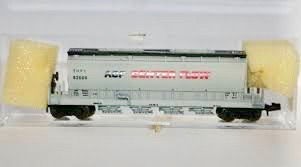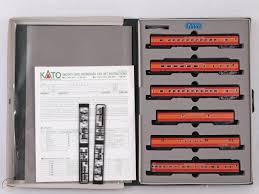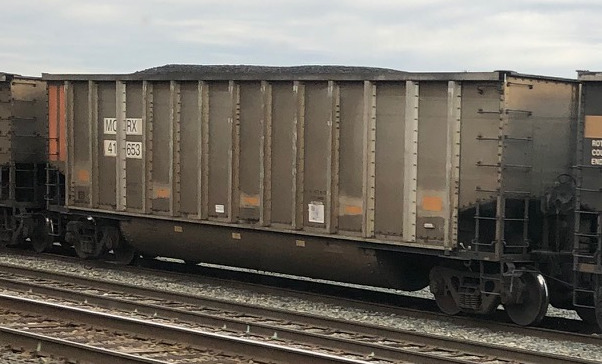Specific Item Information: 193007, 193030, 193075, 193143, 193159, 193212
Model Information: This Intermountain model features some excellent detail work. Of particular note is the handrails at each car end, brake details, and grab irons. The underframes don't have much detail but we suspect that this is true of the prototype as well. Some of the brake components seem to be molded on whereas other parts are separately applied details. Overall the car ends are the highlight of this model. Being an older model, the couplers are truck mounted and plastic wheels are present on the trucks. That being said, InterMountain used MTL Barber truck/couplers and the result is a car that tracks and runs very well. Now, it is possible to swap the wheels with nicely made blackened wheels supplied by Fox Valley, InterMountain and (coming later in 2017) MTL OEM wheels.
On the negative side, the factory-supplied plastic coal loads are a total write-off and should be swapped at your earliest convenience with a Hay Brothers (or equivalent) resin cast load. Please look at item for an example of one of these cars with a Hay Brothers Load
On the negative side, the factory-supplied plastic coal loads are a total write-off and should be swapped at your earliest convenience with a Hay Brothers (or equivalent) resin cast load. Please look at item for an example of one of these cars with a Hay Brothers Load
Prototype History: Since 1982, the BethGon Coalporter has been hauling "black diamonds" across the United States. The largest selling Coal Gondola in the world, the car's double tub design increases hauling capacity while reducing maintenance requirements. Tubs below the car lower the center of gravity, providing a smoother ride.
Today, coal is no longer sold at the volume it once was in the United States, and many coal carrying railroad cars have sadly been left to rust. Bethgon Coalporters could transport 44,000 pounds of these “black diamonds,” a necessity for the railroad in the era of a coal-driven country; therefore, a need of recycling these cars had to be found!
Since the use of grain for animal feed is popular for farmers in the western part of the United States, Bethgons proved up for the challenge and some were converted for use as a Protein Gondola. These covered gondolas are used in freight trains in the western and southern parts of the states in long, endless fleets providing useful feed for farm animals. Since the load of feed is biodegradable and therefore needs to be delivered as quickly as possible, trains carrying these long loads are given top priority on the rails.
Today, coal is no longer sold at the volume it once was in the United States, and many coal carrying railroad cars have sadly been left to rust. Bethgon Coalporters could transport 44,000 pounds of these “black diamonds,” a necessity for the railroad in the era of a coal-driven country; therefore, a need of recycling these cars had to be found!
Since the use of grain for animal feed is popular for farmers in the western part of the United States, Bethgons proved up for the challenge and some were converted for use as a Protein Gondola. These covered gondolas are used in freight trains in the western and southern parts of the states in long, endless fleets providing useful feed for farm animals. Since the load of feed is biodegradable and therefore needs to be delivered as quickly as possible, trains carrying these long loads are given top priority on the rails.
Road Name History: The Canadian National Railway Company (reporting mark CN) is a Canadian Class I railway headquartered in Montreal, Quebec that serves Canada and the Midwestern and Southern United States. CN's slogan is "North America's Railroad". CN is a public company with 24,000 employees. It had a market capitalization of 32 billion CAD in 2011. CN was government-owned, having been a Canadian Crown corporation from its founding to its privatization in 1995. Bill Gates was, in 2011, the largest single shareholder of CN stock.
CN is the largest railway in Canada, in terms of both revenue and the physical size of its rail network, and is currently Canada's only transcontinental railway company, spanning Canada from the Atlantic coast in Nova Scotia to the Pacific coast in British Columbia. Its range once reached across the island of Newfoundland until 1988, when the Newfoundland Railway was abandoned.
Following CN's purchase of Illinois Central (IC) and a number of smaller US railways, it also has extensive trackage in the central United States along the Mississippi River valley from the Great Lakes to the Gulf of Mexico. Today, CN owns about 20,400 route miles (32,831 km) of track in 8 provinces (the only two not served by CN are Newfoundland & Labrador and Prince Edward Island), as well as a 70-mile (113 km) stretch of track (see Mackenzie Northern Railway) into the Northwest Territories to Hay River on the southern shore of Great Slave Lake; it is the northernmost rail line anywhere within the North American Rail Network, as far north as Anchorage, Alaska (although the Alaska Railroad goes further north than this, it is isolated from the rest of the rail network).
The railway was referred to as the Canadian National Railways (CNR) between 1918 and 1960, and as Canadian National/Canadien National (CN) from 1960 to the present.
Read more on Wikipedia.
CN is the largest railway in Canada, in terms of both revenue and the physical size of its rail network, and is currently Canada's only transcontinental railway company, spanning Canada from the Atlantic coast in Nova Scotia to the Pacific coast in British Columbia. Its range once reached across the island of Newfoundland until 1988, when the Newfoundland Railway was abandoned.
Following CN's purchase of Illinois Central (IC) and a number of smaller US railways, it also has extensive trackage in the central United States along the Mississippi River valley from the Great Lakes to the Gulf of Mexico. Today, CN owns about 20,400 route miles (32,831 km) of track in 8 provinces (the only two not served by CN are Newfoundland & Labrador and Prince Edward Island), as well as a 70-mile (113 km) stretch of track (see Mackenzie Northern Railway) into the Northwest Territories to Hay River on the southern shore of Great Slave Lake; it is the northernmost rail line anywhere within the North American Rail Network, as far north as Anchorage, Alaska (although the Alaska Railroad goes further north than this, it is isolated from the rest of the rail network).
The railway was referred to as the Canadian National Railways (CNR) between 1918 and 1960, and as Canadian National/Canadien National (CN) from 1960 to the present.
Read more on Wikipedia.
Brand/Importer Information: InterMountain was founded in 1985 by Fred Brummet. They got started in the model railroad business by producing O-Scale model kits. They got started in the N Scale business almost a decade later when in 1994 they introduced the 40-23 reefer car in kit form. Later, in 1998, they started producing RTR (Ready-to-Run) models. By the early 2000s, InterMountain phased out kit production in favor of the RTR models.
The InterMountain Railway company is located at 1224 Boston Ave in Longmont, CO. They are a manufacturer of HO, N and Z scale model trains. They have produced kits as well as RTR (Ready-To-Run) models. Their N Scale products include locomotives as well as rolling stock. Their rolling stock lineup includes Boxcars, Hoppers, Tank Cars, Reefers, Gondolas, Stock Cars and Flatcars.
Their locomotive releases have primarily been diesel units, with the one major exception being their series of AC-12 Cab Forward steam locos. Their diesel lineup includes F3's, F7's, F9's, SD40's, SD45's and FT units. They are known for quality and detail. They also release their rolling stock in larger varieties of road numbers than most of the other manufacturers.
The InterMountain Railway company is located at 1224 Boston Ave in Longmont, CO. They are a manufacturer of HO, N and Z scale model trains. They have produced kits as well as RTR (Ready-To-Run) models. Their N Scale products include locomotives as well as rolling stock. Their rolling stock lineup includes Boxcars, Hoppers, Tank Cars, Reefers, Gondolas, Stock Cars and Flatcars.
Their locomotive releases have primarily been diesel units, with the one major exception being their series of AC-12 Cab Forward steam locos. Their diesel lineup includes F3's, F7's, F9's, SD40's, SD45's and FT units. They are known for quality and detail. They also release their rolling stock in larger varieties of road numbers than most of the other manufacturers.
Item created by: CNW400 on 2021-01-20 16:15:48
If you see errors or missing data in this entry, please feel free to log in and edit it. Anyone with a Gmail account can log in instantly.
If you see errors or missing data in this entry, please feel free to log in and edit it. Anyone with a Gmail account can log in instantly.


